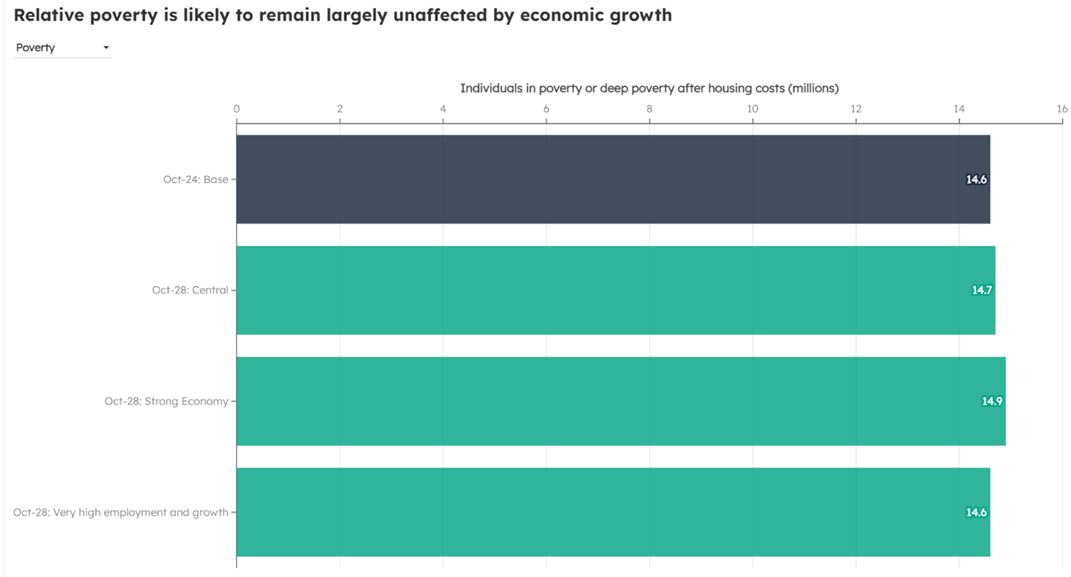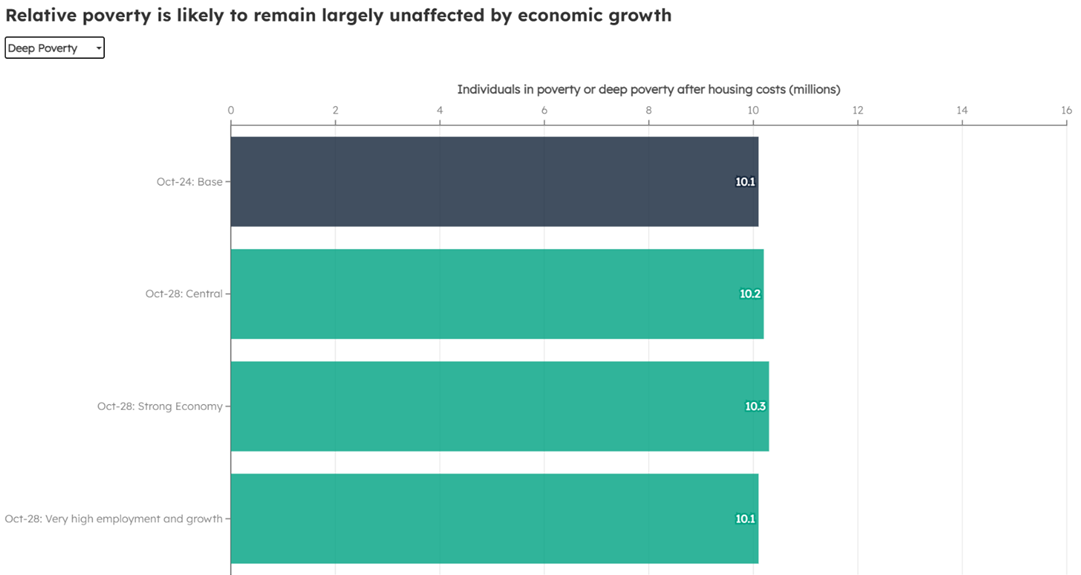New research shows that a strong economy alone will not move the
dial on poverty during this parliament raising questions about
the Chancellor's growth first strategy.
- Analysis based on the OBR's central estimates suggests
poverty will remain broadly flat at around 14 and a half million
people between 2024 and the end of 2028 and this does not improve
even if the UK has the highest GDP per capita growth in the G7
and achieves an 80% employment rate.
- A strong economy can increase wages and jobs but JRF analysis
finds it does very little to reduce working age poverty (broadly
flat at just over 8 million), or child poverty (stays around
4.3-4.5 million) as the gap in living standards between those on
low incomes and middle incomes remains broadly unchanged despite
economic growth.
- JRF is calling on the government to see poverty reduction as
part of its approach to long term and lasting growth. Investing
in social foundations like housing, welfare and public services
must be part of the strategy for securing lasting growth, not
something that can wait to come later.
The Joseph Rowntree Foundation analysis shows the risks of the
government's decision to pursue economic growth before improving
the lives of families who have struggled through the last few
difficult years. JRF warns that unless the government invests in
the social foundations now, not only does the economy risk
leaving millions behind, but growth itself may be harder to
achieve and harder to sustain.
The research used estimates mostly sourced from the OBR to look
at what will happen to relative poverty across the parliament
depending on different scenarios for earnings, inflation,
employment and housing costs. If the economy was at its
strongest, with employment at 80% and wages increasing quickly,
there would be a small drop in poverty of around 100,000 to
200,000 by 2028 compared to the OBR's central scenario, but
essentially unchanged compared to 2024.
, Director and Chief
Economist of the Joseph Rowntree Foundation said:
There is something that both millions of families, and rebuilding
the foundations of the economy, have in common: neither can
afford to wait for growth. Families that don't have the means to
stay secure and healthy may contribute less at work, spend less
today and invest less in tomorrow.
“The government's current approach not only risks leaving
millions behind who can least afford it, it also risks failing on
its own terms to deliver sustained and resilient economic growth.
Unless business investment is matched with stronger social
foundations from the start, growth will be harder to achieve now,
and easier to lose to the next economic shock.”
The main scenarios modelled by JRF are:
-
Central – which uses the OBR's central
forecasts for inflation, earnings, employment, and housing
costs
-
Strong economy – which uses higher earnings
and employment forecasts, and central forecasts for inflation
and housing costs
-
Very high employment and growth – which uses
the higher earnings growth forecast, with central forecasts for
inflation and housing costs, and assumes Labour's ambition of
an 80% working-age employment rate is met in 2028. This
scenario is also consistent with UK GDP growth being the
highest amongst the G7 nations over the same period, in line
with the government's primary macroeconomic objective, as is
the strong economy scenario.
We have also looked at a more negative scenario:
-
Weak economy – which uses a forecast with
higher inflation, lower earnings growth, lower employment, and
higher housing costs compared to the central scenario


In the very high employment and growth scenario poverty is made
up of a higher proportion of pensioners and a lower proportion of
working-age individuals compared to the central scenario, given
the fact that employment increases predominantly benefit
working-age adults.
